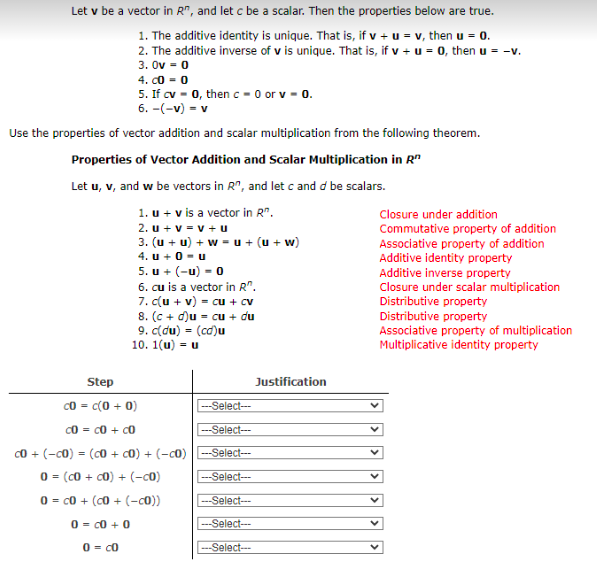1. The additive identity is unique. That is, if v + u = v, then u = 0. 2. The additive inverse of v is unique. That is, if v + u = 0, then u = -v. 3. Ov = 0 4. co - 0 5. If cv - 0, then c - 0 or v - 0. 6. -(-v) = v e the properties of vector addition and scalar multiplication from the following theorem. Properties of Vector Addition and Scalar Multiplication in R" Let u, v, and w be vectors in R", and let c and d be scalars. 1. u + v is a vector in R". 2. u + v- v + u 3. (u + u) + w - u + (u + w) 4. u + 0 -u 5. u + (-u) - 0 6. cu is a vector in R". 7. cu + v) = cu + cv 8. (c + d)u = cu + du 9. c(du) = (cơ)u 10. 1(u) = u Closure under addition Commutative property of addition Associative property of addition Additive identity property Additive inverse property Closure under scalar multiplication Distributive property Distributive property Associative property of multiplication Multiplicative identity property Step Justification c0 = c(0 + 0) --Select--- c0 = c0 + c0 ---Select-- D+ (-c0) = (c0 + c0) + (-c0) -Select-- 0 = (c0 + c0) + (-co) 0 = c0 + (c0 + (-co)) 0 = c0 + 0 ---Select--- --Select-- --Select-- 0 = c0 --Select--
1. The additive identity is unique. That is, if v + u = v, then u = 0. 2. The additive inverse of v is unique. That is, if v + u = 0, then u = -v. 3. Ov = 0 4. co - 0 5. If cv - 0, then c - 0 or v - 0. 6. -(-v) = v e the properties of vector addition and scalar multiplication from the following theorem. Properties of Vector Addition and Scalar Multiplication in R" Let u, v, and w be vectors in R", and let c and d be scalars. 1. u + v is a vector in R". 2. u + v- v + u 3. (u + u) + w - u + (u + w) 4. u + 0 -u 5. u + (-u) - 0 6. cu is a vector in R". 7. cu + v) = cu + cv 8. (c + d)u = cu + du 9. c(du) = (cơ)u 10. 1(u) = u Closure under addition Commutative property of addition Associative property of addition Additive identity property Additive inverse property Closure under scalar multiplication Distributive property Distributive property Associative property of multiplication Multiplicative identity property Step Justification c0 = c(0 + 0) --Select--- c0 = c0 + c0 ---Select-- D+ (-c0) = (c0 + c0) + (-c0) -Select-- 0 = (c0 + c0) + (-co) 0 = c0 + (c0 + (-co)) 0 = c0 + 0 ---Select--- --Select-- --Select-- 0 = c0 --Select--
Linear Algebra: A Modern Introduction
4th Edition
ISBN:9781285463247
Author:David Poole
Publisher:David Poole
Chapter4: Eigenvalues And Eigenvectors
Section4.2: Determinants
Problem 7AEXP
Related questions
Question
dfjsadkfojhfsliegkdfa

Transcribed Image Text:Let v be a vector in R", and let c be a scalar. Then the properties below are true.
1. The additive identity is unique. That is, if v + u = v, then u = 0.
2. The additive inverse of v is unique. That is, if v + u = 0, then u = -v.
3. Ov = 0
4. co - 0
5. If cv - 0, then c - 0 or v - 0.
6. -(-v) = v
Use the properties of vector addition and scalar multiplication from the following theorem.
Properties of Vector Addition and Scalar Multiplication in R"
Let u, v, and w be vectors in R", and let c and d be scalars.
1. u + v is a vector in R".
2. u + v = v + u
3. (u + u) + w = u + (u + w)
4. u +0 - u
5. u + (-u) - 0
6. cu is a vector in R".
7. c(u + v) = cu + cv
8. (c + d)u = cu + du
9. c(du) = (cd)u
10. 1(u) = u
Closure under addition
Commutative property of addition
Associative property of addition
Additive identity property
Additive inverse property
Closure under scalar multiplication
Distributive property
Distributive property
Associative property of multiplication
Multiplicative identity property
Step
Justification
c0 = c(0 + 0)
-Select--
c0 = c0 + c0
--Select--
c0 + (-c0) = (c0 + c0) + (-c0) -Select--
0 = (c0 + c0) + (-c0)
---Select---
0 = c0 + (c0 + (-c0))
---Select---
0 = c0 + 0
--Select--
0 = c0
-Select---
Expert Solution
This question has been solved!
Explore an expertly crafted, step-by-step solution for a thorough understanding of key concepts.
Step by step
Solved in 2 steps with 2 images

Recommended textbooks for you

Linear Algebra: A Modern Introduction
Algebra
ISBN:
9781285463247
Author:
David Poole
Publisher:
Cengage Learning

Elementary Linear Algebra (MindTap Course List)
Algebra
ISBN:
9781305658004
Author:
Ron Larson
Publisher:
Cengage Learning

Algebra & Trigonometry with Analytic Geometry
Algebra
ISBN:
9781133382119
Author:
Swokowski
Publisher:
Cengage

Linear Algebra: A Modern Introduction
Algebra
ISBN:
9781285463247
Author:
David Poole
Publisher:
Cengage Learning

Elementary Linear Algebra (MindTap Course List)
Algebra
ISBN:
9781305658004
Author:
Ron Larson
Publisher:
Cengage Learning

Algebra & Trigonometry with Analytic Geometry
Algebra
ISBN:
9781133382119
Author:
Swokowski
Publisher:
Cengage